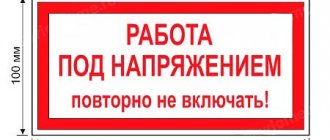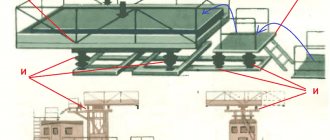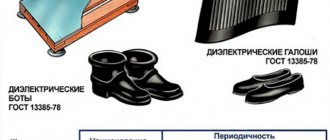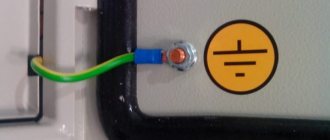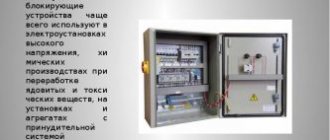Prohibition posters
Based on the name of these posters, their main purpose is to prohibit certain actions with switching installations, so that during maintenance activities on electrical devices they are not accidentally supplied with power.
“ Working under tension. Do not turn it on again! "- no one is allowed to re-turn on the overhead line switches after they have been automatically turned off, without prior consent from the work manager. This type of poster is hung on all overhead line control keys when repair work is carried out on live equipment (U).
" Dangerous! Electric field! Passage is prohibited without protective equipment ” is installed on outdoor switchgear with U exceeding 330 kV at a height of 1.8 meters on the fences of areas with U exceeding 15 kV per meter. It informs about the high probability of dangerous effects of an electric field on operating personnel and prohibits their movement in the work area without personal protective equipment.
" Do not turn on. People are working " is a portable sign used on electrical installations with U over 1 thousand Volts. It is installed on all drives, buttons and control keys of switching equipment and means that power supply to the line is prohibited.
" Do not turn on! Work on the line "is a portable sign installed on all drives and control keys of switching devices.
It prohibits power supply to the line.
Classification of information posters and signs
Electrical safety posters used in electrical installations are used to inform personnel, as well as people who value their own lives.
Perhaps the most common saying is “don’t get involved, he’ll kill you!”, and most often this inscription is accompanied by a frightening picture - a skull pierced by lightning. In general, electrical safety posters and signs are distinguished by their variety of types, so they are usually divided into several groups.
According to the installation principle, they can be both portable and stationary, and according to their purpose, they are usually classified into several groups:
- Warning signs. They “signal” that there is electrical equipment located at a short distance, close contact with which can cause electrical injury.
- Prohibiting. Such posters warn that there is a risk of being exposed to voltage. Often prohibition signs can be found on electrical equipment housings.
- Pointing. Usually installed where it is necessary to accurately show the location of portable grounding (grounding location in an electrical installation).
- Prescriptive. Indicate that all work must be carried out in full compliance with safety regulations.
Warning posters
The main purpose of such information signs is to notify personnel about approaching at an unsafe distance to parts of equipment that are under high voltage.
“ Stop! Voltage " - used in installations with U over 1 thousand Volts. The sign notifies you of being in close proximity to live parts of an electrical installation.
" Don't get in! Will kill " - this sign informs about the danger of approaching live parts when climbing a structure.
" Trial! Danger to life " - this sign is mounted on workplace barriers during high-voltage tests and warns of the danger of electric shock.
" Carefully! Electrical voltage - used in electrical installations of any substations and power stations.
It warns against the danger of approaching live parts of the installation.
Specifics of using posters and safety signs
The main purpose of using posters and safety signs is to warn that there is a danger (temporary or permanent) of electric shock. Also, these means make it possible to determine safe zones for specialists performing certain functions, to prevent human contact with energized switching-type technical equipment that is critical to health and life.
There is a mobile option for using posters and a stationary one. Signs are characterized by permanent placement. Posters belong to one of four categories. Depending on the text and graphic content, they perform a specific function. Below we discuss in more detail the operating features of the most common options.
Warning posters
The function of these warning devices is that they indicate that structural elements under the influence of high voltage are approaching a dangerous distance.
“Don't interfere. He will kill!
It signals the danger to which a person who decides to climb a certain structure (power line support) is exposed. There is a risk of injury to the body due to contact with elements through which current is currently passing. The poster is placed on distribution-type devices, on nearby structures to those used by electricians to climb to work areas located at a certain distance from the ground level.
“Stop. Voltage"
Indicates a risk of injury due to electrical current. Scope of application: equipment with voltages up to 1000 V or more. To install the poster in closed type switchgears, fencing (temporary), separating conductors under high voltage (with the stationary barriers removed), as well as identification of passages to which access is temporarily blocked are suitable. Fixed fencing for individual sectors in the immediate vicinity of the sector where people are currently working is also suitable. In open switchgears, the poster is used near the point of work.
Directional posters
A typical representative of this group is the “GROUNDED” sign. It indicates the grounding of a certain section of the electrical installation and the prohibition of the supply of electric current to it.
Its location is usually the drive of the switching equipment. If prohibition and directional posters are used at the same time, the latter should be hung from above. Dimensions according to GOST 100x200 or 50x100 mm, with a corresponding white border width of 13 and 5 mm. The inscription uses white letters located on a blue background.
Electrical Safety Posters
Today I am publishing posters on electrical safety
, which I found in my bins. Copyright: SOWELO Publishing House.
What are posters for? Unlike books, posters present the information presented in books clearly and intelligibly, but at the same time briefly and interestingly. Posters can be used to refresh your memory of necessary information, for training staff, and simply to create a working environment.
However, one should not think that safety posters can completely replace books. For example, for an electrician this is PUE (Electrical Installation Rules). This book, as well as many others, can be freely downloaded on the SamElectric.ru blog from the page.
There are a lot of posters (more than 100), about half of them are in this article, all of them can be downloaded at the end of this article. The rest of the safety posters that are not included in this part are in.
I am posting several posters for display. Naturally, first of all - those that correspond to the topic of my blog - Electrical Safety
For those who are interested in the topic in more depth, or are planning to take the electrical safety exam (for the admission group), I also advise you to visit the pages and (part 2). There you can freely download the books necessary to prepare for the exam.
Well, I’ll comment a little on the posters that will be on display.
Prescriptive posters
Prescriptive posters are used to indicate workplaces (locations of work) in electrical installations, as well as safe approaches to them.
- “WORK HERE” – indicates the workplace.
The dimensions of the prescriptive poster are 100X100 or 250X250 mm. Made in the form of a white square with sides of 80 or 200 mm, respectively, on a blue background. The inscription is made in black letters inside a square. The poster is portable.
- “GET IN HERE” is also a prescriptive poster and is used when the workplace is located at a height; it indicates a safe way to climb to the workplace.
Poster dimensions – 100X100 or 250X250 mm. Just like the “work here” poster, it is made in the form of a white square with sides of 80 or 200 mm on a blue background. The inscription is made in black letters inside a square.
Types and classification by purpose and use
According to this standard, all safety posters and signs are divided into four types:
- basic - used independently and carry the main information on prohibition, warning, prescription and similar actions;
- auxiliary - supplement the main signs with clarifying or reinforcing inscriptions;
- combined - combine the two types listed above in a rectangular plate;
- group – a combination of several main and auxiliary signs for the design of stands and posters with labor protection rules.
Basic safety signs are classified according to their functional purpose into four main types:
- prohibiting – restrict access and impose a ban on certain actions that could lead to an emergency, injury or death of personnel;
- warning - informs about the presence in a specific area of factors dangerous to life and health (toxic substances, laser range, radioactive radiation, etc.);
- prescriptive - remind personnel of the need to comply with certain labor safety rules, whether working in a helmet or wearing protective gloves;
- signs – used to inform staff and visitors of a public production facility about the purpose of this area (a place for smoking or eating, a source of drinking water, etc.).
The listed types of basic signs are widely used in a wide variety of industries and businesses, be it energy, chemical production, nuclear power plants, metallurgy, the agricultural sector or housing and communal services.
There are also three types of information signs that have a narrow specialization, but universal application:
- Fire safety;
- evacuation in emergency situations;
- sanitary and medical purposes.
Fire safety signs occupy a special place in the total mass of all kinds of safety posters. Fire, evacuation and sanitary-medical signs and stands must be installed at all production enterprises, regardless of their specialization and size, in accordance with GOST regulations and the requirements of the Ministry of Emergency Situations. Such safety signs should be present not only in workshops and warehouses, but also in administrative buildings.
Fire, evacuation and medical signs, signs and posters are required to be installed in all educational institutions of any level, in hospitals and clinics, in sports complexes, at public catering facilities, as well as in shopping, entertainment and office centers.
Regulations of the standard
The form, content and design of safety posters and signs are strictly regulated by GOST.12.4.026-2015.
Lighting design
There is also a classification of safety and labor protection signs and posters depending on their lighting design. According to this criterion, four subcategories are distinguished:
- luminous (with external or internal illumination) – used in rooms with poor lighting, as well as in open spaces where work is carried out in the dark;
- non-luminous - used in well-lit rooms and outdoors during the daytime;
- reflective – attract attention when the light from a miner’s headlamp in a mine, car headlights on the roads, at airports, etc. is pointed at them;
- photoluminescent - “accumulate” light, emitting it when the lighting is suddenly turned off in emergency situations, suitable for evacuation, fire and health signs.
The shape and color scheme of safety signs and posters are strictly regulated by the relevant standard. The above design was developed in accordance with certain characteristics of a person’s perception of information that caught his eye in a normal or critical situation. That is why any deviations from the form, content, color and other design features are strictly prohibited and can lead to serious penalties when inspected by regulatory authorities.
Mode of application
By application, safety signs and posters can be of two main types:
- stationary;
- portable.
Stationary signs and posters for prohibiting, warning, prescriptive and other purposes are installed in places where the conditions described in the sign are permanent. This category also includes fire, evacuation and medical signs and information signs.
Portable signs are used for temporary use during repair and installation work or certain hazardous conditions at one of the stages of the technological process.
Requirements for the production and operation of electrical safety signs
If you need to “leave” a sign on a stone, reinforced concrete or wooden surface, then the finished product, presented in the form of a film of the required dimensions with the appropriate inscription, is very problematic to use. Therefore, the required inscription - warning or prohibiting - is applied with paint through a stencil. A self-adhesive label can be applied to metal, painted or other smooth surfaces.
To obtain all the necessary information regarding the installation, size and shape of signs, you must read paragraph 18.5 (PEES appendix. The overall dimensions of information posters and signs can be increased or decreased, but in a certain ratio to the sizes specified in GOST. Increase/ the reduction is a multiple of 2. For example: 2:1, 4:1, etc. Old-style signs can be replaced with modern analogues as they wear out.
Installed on poles and fences of power lines, electrical equipment and devices, doors of power panels, electrical panels and cabinets.
| Cost, rub. per piece (including VAT 18%) | ||||||||||||
| Size, mm | Metal | Plastic | Self-adhesive film | |||||||||
| Circulation, pcs. | 50 | 100 | 200 | from 500 | 50 | 100 | 200 | from 500 | 50 | 100 | 200 | from 500 |
| 150x150 | 224 | 187 | 175 | 163 | 125 | 104 | 97 | 91 | 23 | 20 | 18 | 17 |
| 200x200 | 270 | 225 | 210 | 197 | 147 | 123 | 115 | 107 | 42 | 35 | 32 | 30 |
| 300x150 | 283 | 236 | 220 | 206 | 154 | 128 | 120 | 112 | 47 | 39 | 37 | 34 |
| 250x250 | 329 | 274 | 256 | 239 | 176 | 147 | 137 | 128 | 65 | 54 | 51 | 47 |
| 400x200 | 375 | 312 | 292 | 273 | 199 | 166 | 155 | 145 | 83 | 70 | 65 | 61 |
| 300x300 | 401 | 334 | 312 | 292 | 212 | 177 | 165 | 154 | 94 | 78 | 73 | 68 |
| 500x250 | 492 | 410 | 383 | 358 | 257 | 214 | 200 | 187 | 130 | 109 | 102 | 95 |
| 600x300 | 636 | 530 | 495 | 463 | 328 | 273 | 256 | 239 | 188 | 156 | 146 | 137 |
| 400x400 | 584 | 486 | 455 | 425 | 302 | 252 | 235 | 220 | 167 | 139 | 130 | 121 |
Our company sells posters and signs on electrical safety. They are used to warn strangers, as well as specialists working in the power supply system, about the danger of high voltage electric shock.
As a rule, safety signs are placed in electrical installations, as well as:
- on high-voltage line towers:
- on electrical equipment and electrical appliances under high voltage;
- on the doors of electrical switchboards and substations;
- in control rooms;
- on electrical panels and cabinets;
- on fences that prevent strangers from entering dangerous areas where there is a risk of electric shock.
